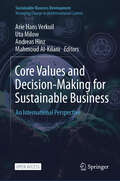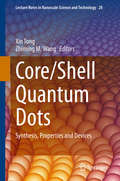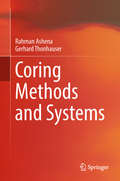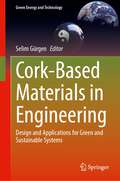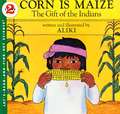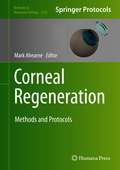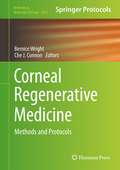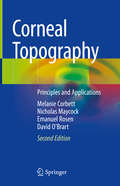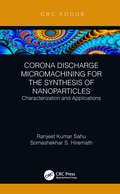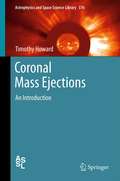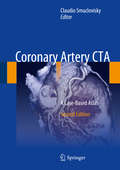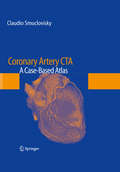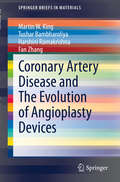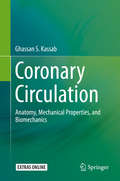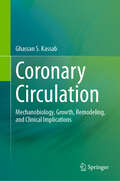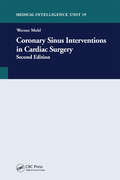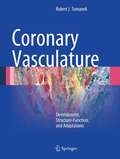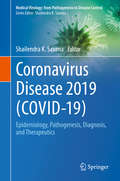- Table View
- List View
Core Samples: A Climate Scientist's Experiments in Politics and Motherhood
by Anna Farro HendersonPeople live by their stories—how can we use them to accelerate action on climate change? Climate scientist and policy expert Anna Farro Henderson embarks on a remarkable narrative journey in Core Samples, exploring how science is done, discussed, legislated, and imagined. Through stories both raucous and poignant—of far-flung expeditions, finding artistic inspiration in research, and traversing the systemic barriers women and mothers face in science and politics—she brings readers into the daily rhythms and intimacies of scientific research and political negotiation. Grounded in her experiences as a climate scientist, an environmental policy advisor to Minnesota Senator Al Franken and Governor Mark Dayton, and a constant juggler of the many roles and responsibilities of professional moms, Henderson&’s eclectic, unconventional essays range from observations, confessions, and meditations on lab and fieldwork to a packing list for a trip to the State Capitol and a lactation diary. Readers are invited on voyages as far afield as the Trinity nuclear test site in New Mexico, the Juneau Icefield in Alaska, and a meteor crater in Ghana—and as close to home as a town hall meeting in America&’s corn belt. A love letter to science and a bracing (and sometimes hilarious) portrait of the many obstacles women, mothers, and people digging for truth navigate, Core Samples illuminates the messy, contradictory humanity of our scientific and political institutions. Bringing us behind the closed doors of discovery and debate, Henderson exposes the flaws in research institutions, the halls of government, and the role of science in policy, yet she shows how each crack is also an invitation for camaraderie, creativity, and change.
Core Science class 10 - Meghalaya Board
by Meghalaya Board of School EducationCore Science for Class 10 is based on the recommendations of the NCF 2005 guidelines and the syllabus designed by the MBOSE. The textbook unfolds to the students the three basic branches of Science-Physics, Chemistry and Biology. The book consists of Important terms and definitions, various types of numerical problems with solved examples with experiments related to each topic. The exercises include a variety of questions such as – MCQs, Very short answer questions, Short answer questions-l, Short answer questions-II and Long answer questions.
Core Science class 9 - Meghalaya Board
by Meghalaya Board of School EducationCore Science for Class 9 is based on the recommendations of the NCF 2005 guidelines and the syllabus designed by the MBOSE. The textbook unfolds to the students the three basic branches of Science-Physics, Chemistry and Biology. The book consists of Important terms and definitions, various types of numerical problems with solved examples with experiments related to each topic. The exercises include a variety of questions such as – MCQs, Very short answer questions, Short answer questions-l, Short answer questions-II and Long answer questions.
Core Values and Decision-Making for Sustainable Business: An International Perspective (Sustainable Business Development)
by Mahmoud Al-Kilani Arie Hans Verkuil Uta Milow Andreas HinzThis open access volume discusses the core values and decision-making for sustainable business in general, and includes research findings and country cases on addressing challenges. It emphasizes the importance of adapting products or services to local needs, considering cultural differences and sustainability. Some of the chapters address questions related to improving sustainability in micro, small and medium-sized enterprises (MSMEs), and cover circular economy and responsible consumption. Others look at the normative framework conditions for business development; sustainability in supply chains; the involvement of stakeholders and their influence on market presence; entrepreneurial decision-making for sustainability; and approaches to teaching international and sustainability-oriented entrepreneurship. The volume sheds light on the pivotal role MSMEs play in shaping a sustainable future and is written for researchers, practitioners, and students working on related topics.
Core-Shell Nano Constructs for Cancer Theragnostic: Current Scenario, Challenges and Regulatory Aspects
by Jayvadan K. Patel Namdev Dhas Gaurav Kant SaraogiThis book addresses the critical challenge in cancer treatment, focusing on the precise delivery of therapeutic agents to cancer cells while sparing healthy tissue. It emphasizes the limitations of current cancer therapies and highlights the potential of nanotechnology to revolutionize cancer treatment. It discusses how core-shell nano constructs, with their enhanced stability, biocompatibility, and targeting capabilities, emerge as a promising solution. The book covers the synthesis of novel core-shell nano constructs while elaborating on the chemistry involved in their fabrication. It explores various therapeutic and diagnostic applications of these nano constructs in cancer treatment, considering different materials such as polymers, lipids, and metals and the importance of diagnostics, biosensors, and targeting strategies to achieve site-specific delivery while minimizing toxicity to healthy cells. Additionally, the book addresses regulatory and commercialization aspects,emphasizing the need for comprehensive characterization techniques to assess the effectiveness of core-shell nano constructs. This book is an invaluable resource for students, researchers, and professionals in the field.
Core-Shell and Yolk-Shell Nanocatalysts (Nanostructure Science and Technology)
by Hiromi Yamashita Hexing LiThis book introduces recent progress in preparation and application of core-shell and yolk-shell structures for attractive design of catalyst materials. Core-shell nanostructures with active core particles covered directly with an inert shell can perform as highly active and selective catalysts with long lifetimes. Yolk-shell nanostructures consisting of catalytically active core particles encapsulated by hollow materials are an emerging class of nanomaterials. The enclosed void space is expected to be useful for encapsulation and compartmentation of guest molecules, and the outer shell acts as a physical barrier to protect the guest molecules from the surrounding environment. Furthermore, the tunability and functionality in the core and the shell regions can offer new catalytic properties, rendering them attractive platform materials for the design of heterogeneous catalysts. This book describes the recent development of such unique nanostructures to design effective catalysts which can lead to new chemical processes. It provides an excellent guide for design and application of core-shell and yolk-shell structured catalysts for a wide range of readers working on design of attractive catalysts, photocatalysts, and electrocatalysts for energy, environmental, and green chemical processes.
Core/Shell Quantum Dots: Synthesis, Properties and Devices (Lecture Notes in Nanoscale Science and Technology #28)
by Zhiming M. Wang Xin TongThis book outlines various synthetic approaches, tuneable physical properties, and device applications of core/shell quantum dots (QDs). Core/shell QDs have exhibited enhanced quantum yield (QY), suppressed photobleaching/blinking, and significantly improved photochemical/physical stability as compared to conventional bare QDs. The core-shell structure also promotes the easy tuning of QDs’ band structure, leading to their employment as attractive building blocks in various optoelectronic devices. The main objective of this book is to create a platform for knowledge sharing and dissemination of the latest advances in novel areas of core/shell QDs and relevant devices, and to provide a comprehensive introduction and directions for further research in this growing area of nanomaterials research.
Core: A Science-Backed Approach to Exercising and Understanding Our Central Anatomy
by Owen LewisA holistic, in-depth guide to understanding 'core' strength for therapists, movement professionals, and serious enthusiasts seeking advanced insights into functional training for mental and physical healthHealth magazines, gym-class instructors, and YouTube fitness experts frequently speak of the importance of a strong &“core,&” the muscles at our body&’s center that provide stability and support our movement. We know that improved core function can reduce symptoms of low back pain and pelvic pain, incontinence, and breathing issues. But while the core may be well-known, it is still poorly understood: there is no universally agreed-upon definition of the core or the muscles it comprises. Core adopts a holistic yet practical approach to demystifying the core, considering this crucial muscle group for its physical importance to bodily movement as well as our emotional and spiritual center. Physical therapist Owen Lewis digs into a wide range of metaphors and frameworks used to understand the core—from the Japanese concept of hara, a central storehouse of energy, to the set of specific muscles referenced in fitness studios everywhere. While physical therapy and core-exercise regimens tend to emphasize strength building and stable posture, Lewis argues for an approach that is also flexible, fluid, and adaptable: the same exercises may not be appropriate for every person, and may need to be changed up over time. In some cases, a &“weak&” core may be the result of muscles that are overworked and stressed, and &“good&” posture may create more pain than it prevents. Lewis clearly explains how the core works to manage and transfer the force of movement through the center of the body, building on principles of biotensegrity (how the tension and compression of different muscles creates a balanced structure which distributes stress and strain). The final chapters of the book provide a range of useful, functional training exercises suitable for lay readers but especially helpful as examples for therapists and trainers to use with clients.Lewis emphasizes functional training and underlying principles over a static list of exercises, providing the groundwork for tailored, individual training to improve core function. Supplemented throughout with color photos and a diverse range of models, Core makes it easy to understand the anatomy of this crucial region of the body, as well as key principles for more effective and safe exercises and training regimens.
Coring Methods and Systems
by Gerhard Thonhauser Rahman AshenaThis book is a practical guide to downhole rock sampling and coring concepts, methods, systems, and procedures for practitioners and researchers. Its chapters are based upon years of extensive studies and research about the coring methods and via direct and continuous communication and consultation obtained from various service and operator companies such as Baker Hughes GE, NOV, OMV, and Sandvik. The contributors discuss the state-of-the-art coring methods and systems (mainly used in the petroleum industry), which include: · conventional coring; · wireline continuous coring; · invasion mitigation coring (low invasion, gel coring, sponge coring); · jam-detection, anti-jamming, full closure; · safe-coring and tripping; · oriented-coring; · pressure/in-situ coring; · logging-while-coring; · motor coring; · mini-coring; · coiled Tubing Coring; and · underbalanced coring. The contributors provide practical and applicable understanding of the procedures of these coring methods and systems, as well as the specific core barrel components, working mechanisms, and schematics of the tools and processes used. Because Coring Methods and Systems analyses and compares the core barrels used in both petroleum and mining industries, it enhances the communication and may allow knowledge transfer between the two industries. As core damage is a serious issue during coring and handling jeopardizing correct calibration of exploration data, Coring Methods and Systems has greatly focused on its identification and its mitigation. Therefore, it can be used as an ideal source for geologists, core analysts, and reservoir engineers, to ensure the retrieval of high-quality cores.
Cork-Based Materials in Engineering: Design and Applications for Green and Sustainable Systems (Green Energy and Technology)
by Selim GürgenCork-Based Materials in Engineering Applications provides a set of case studies investigating cork as an eco-friendly and sustainable engineering material. This natural material has had limited applications in engineering until recent years. Recent regulations by European authorities calling for reducing environmentally hazardous and non-recyclable materials have increased interest in cork-based science. Contributors look at cork-based engineering applications, including crashworthiness applications, anti-impact structures, energy-absorbing systems, and vibration-damping devices. Researchers, scientists, students, and practicing engineers working in advanced materials and natural composites will find this unique book an invaluable reference and introduction to the world of cork-based materials and applications.
Corn Is Maize: The Gift Of The Indians
by AlikiPopcorn, corn on the cob, cornbread, tacos, tamales, and tortillas—all of these and many other good things come from one amazing plant. With simple prose and beautiful illustrations, award-winning author-illustrator Aliki tells the story of how Native American farmers thousands of years ago found and nourished a wild grass plant and made corn an important part of their lives. This is a Stage 2 Let's-Read-and-Find-Out, which means the book explores more challenging concepts for children in the primary grades. Let's-Read-And-Find-Out is the winner of the American Association for the Advancement of Science/Subaru Science Books & Films Prize for Outstanding Science Series. Supports the Common Core Learning Standards and Next Generation Science Standards
Corneal Regeneration: Methods and Protocols (Methods in Molecular Biology #2145)
by Mark AhearneThis volume details different laboratory techniques used to develop regenerative therapies that help treat corneal blindness. Chapters guide readers through methods and protocols on optimal cell culture conditions, gene-editing techniques, multiple types of scaffold for corneal regeneration, how to evaluate the success of these therapies, and cell and material characterization techniques. Written in the highly successful Methods in Molecular Biology series format, chapters include introductions to their respective topics, lists of the necessary materials and reagents, step-by-step, readily reproducible laboratory protocols, and tips on troubleshooting and avoiding known pitfalls.Authoritative and cutting-edge, Corneal Regeneration: Methods and Protocols aims to be useful for new and experienced laboratory researchers working on different aspects of corneal regeneration.
Corneal Regenerative Medicine: Methods and Protocols (Methods in Molecular Biology #1014)
by Che J Connon Bernice WrightContinuous regeneration of the cornea is necessary to maintain this tissue in the transparent state that is essential for vision. Therapy for repair of the damaged anterior cornea is currently addressed through the transplantation of donor corneas or the delivery of limbal epithelial stem cells (LESC) to the ocular surface using amniotic membrane (AM) as a supporting scaffold. Research on the bioengineering of corneal equivalents as replacement tissue is underway to develop viable corneal prosthetics. Corneal Regenerative Medicine: Methods and Protocols provides a concise overview of essential techniques in the field of corneal regenerative medicine, highlighting novel strategies to guide the management of key therapies within this area of medicine. Divided into four convenient sections, topics include the identification, characterisation and cultivation of LESC, as well as the investigation of biopolymers used as the basis for corneal substitutes. Written in the successful Methods in Molecular Biology series format, chapters include introductions to their respective topics, lists of the necessary materials and reagents, step-by-step, readily reproducible protocols, and notes on troubleshooting and avoiding known pitfalls. Authoritative and easily accessible, Corneal Regenerative Medicine: Methods and Protocols covers the fundamental techniques useful for both the laboratory and clinical settings.
Corneal Topography: Principles and Applications
by Emanuel Rosen Melanie Corbett Nicholas Maycock David O'BrartThe new edition of this leading text atlas on corneal topography has been updated to include the latest advances in technology, such as Pentacam and Orbscan. The principles and theory underlying each technology are first clearly explained, and clinical applications are then examined. The authors describe how to use the different technologies and devices, explain the clinical readout with illustrations of normal corneal topography, discuss applications and findings in common disease states, and present the appearances after various corneal surgical procedures. The pros and cons of each system are highlighted. This up-to-date, superbly illustrated book is the most comprehensive guide to corneal topography currently available. It is anticipated that this second edition will become the seminal corneal topography textbook for all with an interest in corneal disease and its management, and refractive surgery.
Corona Discharge Micromachining for the Synthesis of Nanoparticles: Characterization and Applications
by Ranjeet Kumar Sahu Somashekhar S HiremathThis book summarizes the fundamental and established methods for the synthesis of nanoparticles, providing readers with an organized and comprehensive insight into the field of nanoparticle technology. In addition to exploring the characterization and applications of nanoparticles, it also focuses on the recently explored corona discharge micromachining - Electrical Discharge Micromachining (EDMM) - method to synthesize inorganic nanoparticles. In the synthesis of nanoparticles, organic materials often play an indispensable role, such as providing stabilizers in the form of capping agents. <P><P>This book will be of interest to advanced undergraduate and graduate students studying physics and engineering, as well as professionals and academics looking for an introduction to the nature and foundations of nanoparticle synthesis. <P><P> Features: Provides diagnostic tools for the characterization of nanoparticles Explores the cutting-edge EDMM method for the synthesis and characterization of nanoparticles Discusses possible methods to overcome agglomeration of nanoparticles and achieve stable dispersion, in addition to examining the application suitability of synthesized nanoparticles
Coronal Mass Ejections: An Introduction (Astrophysics and Space Science Library #376)
by Timothty HowardThe book introduces the solar coronal mass ejection phenomena. This includes both those observed in the corona and those further from the Sun, known as interplanetary coronal mass ejections. We discuss the history and physics behind these phenomena, theories describing their launch and evolution, association with other solar eruptive phenomena, and methods employed for their detection and scientific data extraction. Instruments used for their study (past, present and future) are also discussed, along with their resulting space weather effects on Earth and other planets. The latter requires a description of the Earth's magnetosphere, which is also included. Coronal Mass Ejections brings together solar physics, heliospheric physics, and magnetospheric physics, three traditionally separate fields of study. The content is accessible to beginning graduate students who are trying to master difficult fundamental concepts.
Coronal Seismology: Waves and Oscillations in Stellar Coronae
by Valery M. Nakariakov Valery V. Zaitsev Alexander StepanovThis concise and systematic account of the current state of this new branch of astrophysics presents the theoretical foundations of plasma astrophysics, magneto-hydrodynamics and coronal magnetic structures, taking into account the full range of available observation techniques -- from radio to gamma. The book discusses stellar loops during flare energy releases, MHD waves and oscillations, plasma instabilities and heating and charged particle acceleration. Current trends and developments in MHD seismology of solar and stellar coronal plasma systems are also covered, while recent progress is presented in the observational study of quasi-periodic pulsations in solar and stellar flares with radio, optical, X and gamma rays. In addition, the authors investigate the origin of coherent radio emission from stellar loops, paying special attention to their fine structure. For advanced students and specialists in astronomy, as well as theoretical and plasma physics.
Coronary Artery CTA
by Claudio SmucloviskyThe second edition of this important work provides a broad range of cardiac CT angiography (CCTA) cases covering normal anatomy, congenital coronary anomalies, coronary artery disease, percutaneous coronary intervention, postsurgical coronary revascularization, and extra-coronary abnormalities. It is designed to help practicing radiologists, cardiologists, and cardiothoracic surgeons understand the current issues involved with clinical, interventional, and surgical management of coronary artery CTA. Each case consists of detailed CCTA images, a brief history, diagnosis, discussion, and pearls and pitfalls. This updated and expanded edition includes new chapters on principles of cardiac CT, patient preparation, cardiomyopathies, pediatric cardiac CT, cardiac CT in the emergency department, CT-FFR, and reporting cardiac CT.
Coronary Artery CTA: A Case-Based Atlas
by Claudio SmucloviskyThis new case-based book fills a gap in the literature by guiding the reader through the challenging clinical problems encountered in daily practice. Each case presents the clinician with a complete patient work-up that includes clinical history, radiological and clinical findings, treatment summary and suggested readings. Ideal for radiology and cardiology residents, as well as experienced physicians, this text helps the reader arrive at a diagnosis for each clinical problem presented.
Coronary Artery Disease and The Evolution of Angioplasty Devices (SpringerBriefs in Materials)
by Fan Zhang Martin W. King Tushar Bambharoliya Harshini RamakrishnaIn this concise but authoritative book, the authors take the reader through the epidemiology, risk factors and the basic mechanism of coronary artery disease. In addition, they explain how coronary microvascular dysfunction can lead to angina, even after successful angioplasty following a heart attack. The methods for diagnosis and the options for treatment are explained, ending with a discussion of the evolution of coronary angioplasty from balloon catheters to novel, fully resorbable polymeric drug eluting stents. Enclosed is a list of currently available commercial devices, as well as a listing of experimental products under research and development, so that readers can appreciate the serious nature of this disease and have an understanding of how the medical device sector is attempting to address this major healthcare problem. Globally in 2010, ischemic heart disease was the cause of 13.3% of all deaths. In the US alone, the direct medical costs from coronary artery disease and stroke are currently estimated to be $126 billion per year, and are expected to rise to $309 billion by 2035.
Coronary Circulation: Anatomy, Mechanical Properties, and Biomechanics
by Ghassan S. KassabThis comprehensive text examines both global and local coronary blood flow based on morphometry and mechanical properties of the coronary vasculature. Using a biomechanical approach, this book addresses coronary circulation in a quantitative manner based on models rooted in experimental data that account for the various physical determinants of coronary blood flow including myocardial-vessel interactions and various mechanisms of autoregulation. This is the first text dedicated to a distributive analysis (as opposed to lumped) and provides digital files for detailed anatomical data (e.g., diameters, lengths, node-to-node connections) of the coronary vessels. This book also provides appendices with specific mathematical formulations for the biomechanical analyses and models in the text. Written by Dr. Ghassan S. Kassab, a leader in the field of coronary biomechanics, Coronary Circulation: Anatomy, Mechanical Properties, and Biomechanics is a synthesis of seminal topics in the field and is intended for clinicians, bioengineers, and researchers as a compendium on the topic. The detailed anatomical and mechanical data provided are intended to be used as a platform to address new questions in this exciting and clinically very important research area.
Coronary Circulation: Mechanobiology, Growth, Remodeling, and Clinical Implications
by Ghassan S. KassabThis book covers mechanobiology, growth, remodeling, and clinical implications of coronary artery disease treatment. This volume presents a comprehensive overview of coronary circulation, including growth and remodeling of coronary vasculature, implications to cardiology, and implications to cardiovascular surgery. General principles of biomechanical homeostasis and mechanobiology are outlined. Specifics topics covered include endothelial mechano-transduction, flow reversal, uniform shear, stress & strain hypotheses, scaling laws in coronary artery disease, growth, and aging, and coronary retroperfusion. Coronary Circulation: Mechanobiology, Growth, Remodeling and Clinical Implications is a vital resource for coronary physiologists and cardiovascular disease researchers and bioengineers who want to learn more about mechanobiology and clinical implications to coronary circulation in health and disease.
Coronary Sinus Intervention in Cardiac Surgery
by Werner MohlTopics include basic considerations and techniques, venous drainage of the myocardium, structure and function of the cardiac lymphatic system, coronary sinus interventions in experimental research, and more.
Coronary Vasculature: Development, Structure-Function, and Adaptations
by Robert J. TomanekIschemic heart disease is the leading cause of morbidity and mortality in the developed world. The high metabolism and oxygen demand of the cardiac myocardium depends on both a high blood flow and a rich capillary density. For this reason, the growth of the coronary vasculature is vital, not only in early development, but also in the adult faced with various stresses. Novel technologies have enabled the discovery of the molecular mechanisms underlying the growth and assembly coronary vessels, and this volume covers the hierarchy of the coronary vasculature from its embryonic origins through its postnatal growth, adulthood, and senescence. Chapters address normal coronary development, coronary anomalies and their possible underlying developmental errors, coronary vessel adaptations to exercise training, aging, hypoxia, myocardial ischemia, and cardiac hypertrophy. This comprehensive overview of current research in coronary vessels and myocardial perfusion was written by Dr. Robert J. Tomanek, Emeritus Professor of Anatomy and Cell Biology at the University of Iowa. The book reviews, discusses, and integrates findings from various areas of coronary vasculature research, and as a result, will be a valuable reference source for cardiovascular scientists and physicians for many years to come.
Coronavirus Disease 2019: Epidemiology, Pathogenesis, Diagnosis, and Therapeutics (Medical Virology: From Pathogenesis to Disease Control)
by Shailendra K. SaxenaThis book provides a comprehensive overview of recent novel coronavirus (SARS-CoV-2) infection, their biology and associated challenges for their treatment and prevention of novel Coronavirus Disease 2019 (COVID-19). Discussing various aspects of COVID-19 infection, including global epidemiology, genome organization, immunopathogenesis, transmission cycle, diagnosis, treatment, prevention, and control strategies, it highlights host-pathogen interactions, host immune response, and pathogen immune invasion strategies toward developing an immune intervention or preventive vaccine for COVID-19. An understanding of the topics covered in the book is imperative in the context of designing strategies to protect the human race from further losses and harm due to SARS-CoV-2 infection causing COVID-19.

